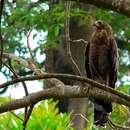Biology
provided by Arkive
The diet of the African harrier-hawk is quite varied, and includes small mammals such as rodents and bats, as well as birds, eggs and nestlings, lizards, amphibians and insects. It may also occasionally take stranded fish or carrion, and in West Africa often feeds on oil-palm fruits (2) (3). While some hunting takes place from low flight over vegetation or by watching for prey from a perch, the African harrier-hawk is notable for its habit of actively searching for prey in trees, nests, rock faces, and from underneath objects on the ground. It can often be seen clambering about and hanging from tree limbs, running up tree trunks with wings flapping, or hanging from foliage or birds' nests as it searches for food (2) (3) (5). A unique feature of harrier-hawks is the remarkable flexibility of their legs and feet, and the long yellow legs and small feet of the African harrier-hawk are able to bend both forwards and backwards through large angles, enabling the bird to reach into nests, holes and crevices to extract otherwise inaccessible prey (2) (3) (8).
The breeding season of the African harrier-hawk varies with location (2) (3). During courtship, the male performs a slow, circling display flight, and, upon being joined by the female, the pair may come together, with the female rolling over and the pair sometimes briefly touching claws in mid-air (3). The nest is usually relatively large and built with sticks, in a tree or on a cliff ledge, and lined with sprays of green leaves. One to three eggs are laid, and hatch after an incubation period of about 35 days. Older chicks often kill younger siblings soon after hatching, with usually only one, or sometimes two, chicks raised, which fledge after 45 to 55 days (2) (3).
Conservation
provided by Arkive
The African harrier-hawk is listed on Appendix II of the Convention on International Trade in Endangered Species (CITES), meaning that international trade in this species should be carefully monitored and controlled (4), and is also listed along with other African birds of prey under Class B of the African Convention on the Conservation of Nature and Natural Resources, meaning that the African harrier-hawk should not be killed or captured without special authorisation (9). The species is also likely to occur in a number of protected areas throughout its range, such as in the Gamba Complex of Protected Areas in Gabon (10).
Description
provided by Arkive
A fairly large but relatively lightweight bird of prey, the African harrier-hawk has a distinctive small, pointed head, with a patch of naked yellow skin on the face which flushes red when the bird is excited (2) (3) (5). On the top of the head is a crest of feathers (2), which may be raised or lowered. The plumage is mainly grey, with neat black and white barring on the abdomen and thighs, though this is absent in some individuals. The wings are long and rounded, with distinct, broad black ends to the flight feathers, and the tail is black and relatively long, with a clear white or grey central band. Male and female African harrier-hawks are similar in appearance, though the female may be slightly larger than the male, while juveniles have brown plumage, blackish facial skin, a brown tail with four darker brown bars, and variable amounts of whitish, reddish-brown or dark bars or streaks on the abdomen (2) (3) (5). Adult plumage is not attained until about the third year (3).
Two subspecies of African harrier-hawk are recognised: Polyboroides typus typus and Polyboroides typus pectoralis, the latter being smaller and darker, with more barring on the underparts (2) (3). The African harrier-hawk is a fairly silent bird, but in the breeding season gives a long, plaintive su-eeeeee-oo call, as well as a high hweep-hweek-hweep near the nest (3) (5).
Habitat
provided by Arkive
Inhabits mainly forest, woodland, wooded savanna, tall riparian vegetation and wooded ravines, up to elevations of around 3,000 metres (2) (3) (7). In large areas of continuous forest, the African harrier-hawk is generally found at the forest edges, in clearings or close to rivers (2) (3), and also readily adapts to partly deforested areas and to plantations, particularly stands of eucalyptus trees (3) (7). In hilly or mountainous terrain the species is often associated with cliff faces, though it also inhabits flat plains (7).
Range
provided by Arkive
The African harrier-hawk is widely distributed throughout sub-Saharan Africa, from Senegal east to Sudan, Eritrea and Ethiopia, and south to South Africa (3) (6), as well as on the island of Pemba (3). P. t. pectoralis occurs from Senegal to western Sudan, and south to Angola and Democratic Republic of the Congo, while P. t. typus has a more eastern and southerly distribution, from eastern Sudan and Eritrea, south through East Africa, eastern Democratic Republic of Congo and Angola, and as far south as South Africa (2) (3). Although resident in most areas, the African harrier-hawk may make some seasonal movements in parts of West Africa and may be locally nomadic in parts of southern Africa (2) (3).
Status
provided by Arkive
Classified as Least Concern (LC) on the IUCN Red List (1) and listed on Appendix II of CITES (4).
Threats
provided by Arkive
The African harrier-hawk is one of the most common birds of prey in parts of West Africa, though it is less common and more patchily distributed in other areas. The species still has a wide range and a large global population, and is not currently considered globally threatened (2) (3) (6). The African harrier-hawk is thought to adapt quite easily to altered environments (3), and its preference for stands of alien trees has even resulted in it colonising new areas (7). There are not thought to be any obvious threats to this species (3), although some isolated incidents of persecution have been reported (7).

